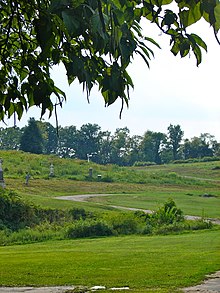Woodlawn Cemetery (Washington, D.C.)

View from the front gate
|
|
| Details | |
|---|---|
| Established | 1895 |
| Location | 4611 Benning Road SE, Washington, D.C. |
| Country | United States |
| Type | secular and public; closed 1970 |
| Owned by | Woodlawn Cemetery Perpetual Care Association |
| Size | 22.5 acres (91,000 m2) |
| No. of graves | 36,000 |
| Website | www |
| Find a Grave | Woodlawn Cemetery |
|
Woodlawn Cemetery
|
|
| Coordinates | 38°53′6″N 76°56′19″W / 38.88500°N 76.93861°WCoordinates: 38°53′6″N 76°56′19″W / 38.88500°N 76.93861°W |
| NRHP Reference # | 96001499 |
| Added to NRHP | December 20, 1996 |
Woodlawn Cemetery is a historic cemetery in the Benning Ridge neighborhood of Washington, D.C., in the United States. The 22.5-acre (91,000 m2) cemetery contains approximately 36,000 burials, nearly all of them African Americans. The cemetery was added to the National Register of Historic Places on December 20, 1996.
The District of Columbia was established in 1791, and for the first 160 years of its existence nearly all cemeteries in the city were segregated by race. Many cemeteries refused to bury African Americans, while others separated whites from "colored people" (African Americans, Native Americans, and Asians). By the 1880s, most of the city's African American population lived in the eastern part of the Federal City and Washington County and east of the Anacostia River. Just two cemeteries met the needs of the city's black populace: Graceland Cemetery (what is now Hechninger Mall at the corner of Maryland Avenue NE and Bladensburg Road NE) and Payne's Cemetery (now the site of Fletcher-Johnson Elementary School and the Fletcher-Johnson Recreation Center).
Woodlawn Cemetery was founded because of a crisis among the black burying grounds. Graceland Cemetery, founded in 1871 on the edge of the Federal City, was rapidly engulfed by residential development. By the early 1890s, the decomposition of bodies in the partially filled cemetery was polluting the nearby water supply and creating a health hazard. The Commissioners of the District of Columbia (the city's government) pressed for the closure of Graceland to accommodate the need for housing. With Graceland on the verge of closing, a number of white citizens decided that a new burial ground, much farther from any development, was needed. Woodlawn's incorporators consisted of five white men: Jesse E. Ergood, president; Charles C. Van Horn, secretary-treasurer; and directors Seymour W. Tullock, William Tindall, and Odell S. Smith. They formed the Woodlawn Cemetery Association, and were incorporated on January 8, 1895. A 22.5-acre (91,000 m2) plot of land adjacent to Payne's Cemetery was purchased, a portion of which was the site of the American Civil War's Fort Chaplin. Burial plots were quickly laid out, and Woodlawn Cemetery opened on May 13, 1895.
...
Wikipedia



